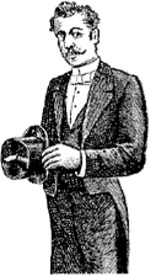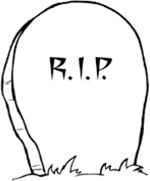Now I Know More (32 page)
Authors: Dan Lewis


THE MAN WHO KEPT COMING BACK
On October 3, 1849, a stranger found Edgar Allan Poe delirious (but, despite some reports, probably not drunk) and stumbling around the streets of Baltimore, Maryland. Poeâwho was usually a very fashionable manâwas wearing unkempt clothing, which fit poorly. His shoes were in dire need of a shine and repair, as the heels had been worn down significantly. Many believed he had been wearing someone else's attire, as his outfit didn't match his reputation. To make matters more interesting but even less clear, no one (publicly, at least) knew of Poe's whereabouts for almost a week before his discovery on the 3rd.
Unfortunately, we'll never know what happened. Poe died on October 7 and never recovered enough during the interim period to explain how he fell into such a state.
Yet, as strange as the circumstances around Poe's death may be, what happened to him generations later is probably stranger. For decades, every year on the same day each year, a costumed man visited Edgar Allan Poe's gravesite, leaving no explanation as to his motives or identity. Then, one year, he stopped, never to return.
The origins of the Poe Toaster, as the Baltimore press and community have dubbed him, are as mysterious as his motives. At some point in the 1930sâthe exact year has been lost to historyâthe Poe Toaster arrived at the author's original gravesite (it was moved in 1875) on January 19, Poe's birthday. Every morning on that day, the Poe Toaster arrived wearing all black (including a wide-brimmed hat) except for a white scarf. A hood obscured the man's face, and he carried with him a silver-tipped cane. He'd pay his respects to the famous man once buried at that site, decorating the grave with three roses and an unfinished bottle of cognac and, at times, leaving a note.
These notes referred to the greatness of Poe, at least in the Toaster's eyes. But in 1993, the already strange gravesite ritual became downright cryptic; the note read, simply, “The torch will be passed.” By then, the Toasterâassuming it was the same person the whole timeâhad been carrying out that ritual for sixty years, and some assumed that he was looking to retire (or had come to terms with his own mortality). This line of speculation became stronger in 1999, when the note referred to the sons of the Toaster. Further, that year, Toaster-watchers noticed that the man in black appeared younger than in previous years.
Thereafter, the notes seemed increasingly out of character for the Toaster. In 2001, the note referenced the upcoming Super Bowl versus the New York Giants and the hometown Ravens, but was markedly proâNew York. In 2004, the Toaster came to the grave during a short but notable anti-French period in the United States, due to France's unwillingness to join in military efforts in Iraq. (Remember “freedom fries”?) The Toaster's note apparently reflected this undercurrent of American sentiment (with poor grammar included): “The sacred memory of Poe and his final resting place is no place for French cognac. With great reluctance but for respect for family tradition the cognac is placed. The memory of Poe shall live evermore!”
In 2009âthe 150th anniversary of Edgar Allan Poe's birthâthe Poe Toaster made his final appearance. Through 2014, he has not appeared again at Poe's grave on January 19, although a handful of copycats (lacking the true Toaster's telltale habits) have come in his place. Jeff Jerome, a former curator of the Poe House and Museum who has collected the Toaster's notes over the years, declared in 2012 that the tradition had come to an endâwith few remaining clues as to the Toaster's true identity.
The Baltimore Ravens are nicknamed for Edgar Allan Poe's famous poem, “The Raven.” From the team's founding in 1996 through 2008, they had three mascotsâall costumed performers dressed as ravensânamed Edgar, Allan, and Poe. For the 2009 season, though, Edgar and Allan were retired and replaced with two live ravens named Rise and Conquer.

WHY YOU CAN'T DIE ALONE IN AMSTERDAM
Every year, countless numbers of people pass away alone, without family or friends to give them a proper funeral. In many places, the government and other organizations take care of the not-so-pleasant stuff like disposing of the person's stuff, figuring out what to do with the body, etc. We won't go into details, but let's just say that they get the stuff done that has to get doneâbut in a bureaucratic way.
However, just because someone dies alone doesn't mean that he or she should be buried unceremoniously. In Amsterdam, at least, such people aren't.
About twenty times a year, someone in Amsterdam dies without next of kin or somebody to claim the deceased's body. That might mean that these people would be buried without anyone noticing, but for roughly twenty-five years, a man named Ger Frits has made sure that doesn't happen. As reported by Radio Netherlands Worldwide in 2010, with the blessing and assistance of Amsterdam's city services Frits became a one-man funeral gathering. After the city agency notified him that someone had died leaving no one behind, Frits would go to the apartment of the recently deceased to get a feel for that person's life, desires, and interests. Then, based on the information he gathered, he'd select some music to play at the funeralâa ceremony only he'd be attending. He'd also bring flowers to leave at the gravesite.
For more than a decade, Frits did this all by himself. Then in 2002, a poet named Frank Starik asked if he could get involved. Starik believed that the recently passed deserve eulogies, even if they don't have friends, and he offered to compose poems for each. Frits appreciated the added dignity that Starik could bring, and suddenly, the two were partners in bringing solemnity to those who would otherwise meet a quiet, unnoticed end.
Today, the pair is known in Amsterdam as
Stichting De Eenzame Uitvaart
âthe Lonely Funeral Foundation. They've started something of a movement. In other cities in the Netherlands and Belgium, volunteers are mimicking Frits and Starik's work, bringing music and poetry to those in their areas who died without friends or relatives.
In 2007, a forty-five-year-old Bosnian man named Amir Vehabovic died. His funeral only had one attendeeâhis mom. Normally this wouldn't be interestingâthat stuff probably happens more than you'd thinkâexcept that Vehabovic wasn't really dead. He suspected that his friends didn't really like him, so he faked his own death (bought a fake death certificate, bribed the undertakers, procured an empty coffin) to see if they cared enough to send their last respects. They didn't.
Copyright © 2014 by Dan Lewis.
All rights reserved.
This book, or parts thereof, may not be reproduced in any form without permission from the publisher; exceptions are made for brief excerpts used in published reviews.
Published by
Adams Media, a division of F+W Media, Inc.
57 Littlefield Street, Avon, MA 02322. U.S.A.
ISBN 10: 1-4405-8215-7
ISBN 13: 978-1-4405-8215-8
eISBN 10: 1-4405-8216-5
eISBN 13: 978-1-4405-8216-5
Many of the designations used by manufacturers and sellers to distinguish their products are claimed as trademarks. Where those designations appear in this book and F+W Media, Inc. was aware of a trademark claim, the designations have been printed with initial capital letters.
Interior illustrations © 123RF and Clipart.com.
Now I Know
title typography by Carla Rozman.
This book is available at quantity discounts for bulk purchases.
For information, please call 1-800-289-0963.
